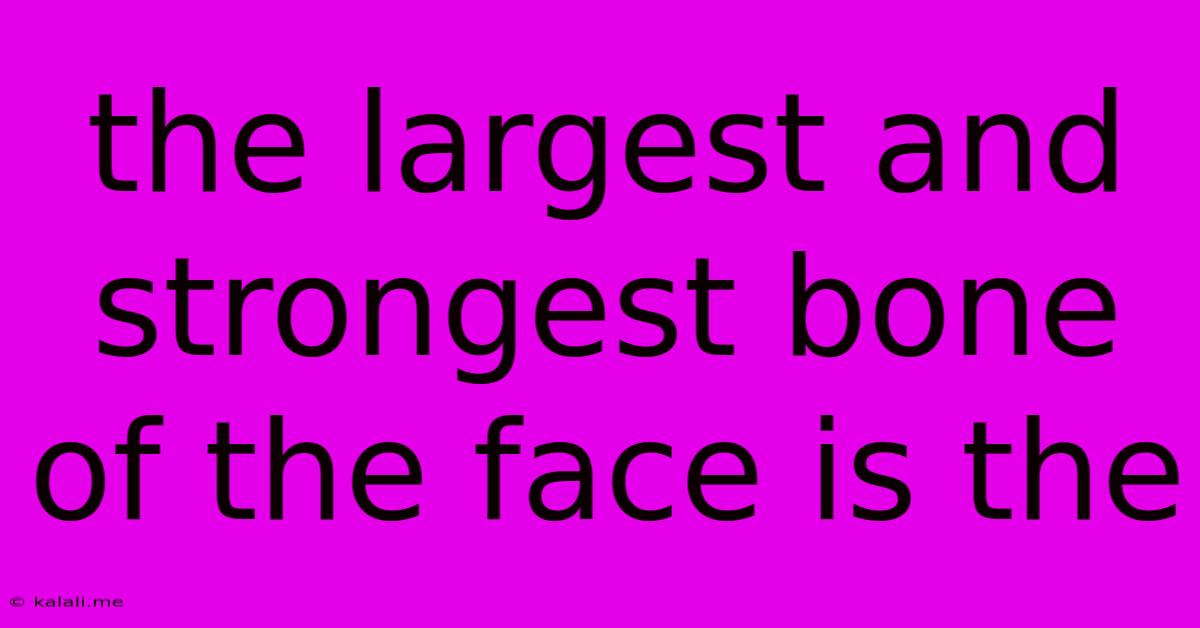The Largest And Strongest Bone Of The Face Is The
Kalali
May 09, 2025 · 3 min read

Table of Contents
The Largest and Strongest Bone of the Face Is the Mandible: A Deep Dive into its Anatomy and Function
The largest and strongest bone of the face is the mandible, also known as the jawbone. This robust bone plays a crucial role in chewing, speaking, and facial expression. Understanding its anatomy and function is essential for appreciating its significance in overall human health. This article will delve into the details of the mandible, exploring its unique structure and the vital role it plays.
This article will discuss the mandible's anatomy, its role in mastication (chewing), its connection to other facial bones, and common conditions that affect it. We'll also explore the significance of its strength and size in facial structure and function.
Anatomy of the Mandible: A Strong Foundation
The mandible is a U-shaped bone located at the lower part of the face. Unlike other facial bones, which are fused together, the mandible is a single, unpaired bone. This unique characteristic allows for its considerable mobility, a key element in its functionality. Its structure includes:
- Body: The horizontal portion of the mandible, forming the chin and lower jawline. This part houses the teeth sockets (alveoli).
- Ramus: The vertical portion rising from each end of the body. Each ramus has two processes:
- Coronoid Process: A flat, triangular projection where the temporalis muscle attaches, crucial for jaw elevation.
- Condylar Process: The rounded projection that articulates with the temporal bone of the skull at the temporomandibular joint (TMJ). This joint allows for the complex movements of the jaw.
- Angle: The area where the body and ramus meet, forming a distinct angle.
- Mental Foramen: A small opening on the anterior surface of the body, providing passage for nerves and blood vessels.
- Alveolar Process: The part of the body that contains the sockets (alveoli) for the lower teeth.
The Mandible's Role in Mastication: Chewing and Beyond
The mandible's strength is directly linked to its primary function: mastication, or chewing. The powerful muscles attached to the mandible, such as the masseter, temporalis, and medial pterygoid, work in concert to elevate, depress, protrude, and retract the jaw, allowing for efficient breakdown of food. This complex interplay of muscles and bone is a marvel of biomechanics. The strength of the mandible is crucial to withstand the forces generated during chewing, particularly when consuming hard or tough foods.
Beyond mastication, the mandible also plays a critical role in:
- Speech: Precise movements of the mandible are essential for clear and articulate speech.
- Facial Expression: Its movement contributes to various facial expressions, affecting the overall appearance and communication.
The Mandible's Connection to Other Facial Bones: A Complex Network
The mandible doesn't exist in isolation. It articulates with the temporal bones of the skull at the temporomandibular joints (TMJs), forming a critical connection between the skull and the lower jaw. This connection allows for the jaw's mobility and stability. Its relationship with other facial bones, particularly the maxilla, influences the overall shape and structure of the face.
Conditions Affecting the Mandible: Maintaining Jaw Health
Several conditions can affect the mandible, including:
- Fractures: The mandible is susceptible to fractures due to trauma.
- TMJ Disorders: Problems with the temporomandibular joint can lead to pain, clicking, and limited jaw movement.
- Infections: Infections such as osteomyelitis can affect the bone.
- Cysts and Tumors: Benign and malignant lesions can develop within the mandible.
Maintaining good oral hygiene, a balanced diet, and seeking prompt medical attention for any jaw pain or injury are crucial for preserving the health and function of this vital facial bone.
In conclusion, the mandible's size and strength are essential for its multifaceted functions. Its complex anatomy and critical role in chewing, speech, and facial expression highlight its importance in overall human health and functionality. Understanding its structure and potential vulnerabilities is key to appreciating this remarkable bone and maintaining its well-being.
Latest Posts
Latest Posts
-
How Tall Is 163 Cm In Height
May 09, 2025
-
Is A Rhombus A Regular Polygon
May 09, 2025
-
200 Mg Equals How Many Grams
May 09, 2025
-
What Percent Is 21 Out Of 25
May 09, 2025
-
Lcm Of 5 3 And 4
May 09, 2025
Related Post
Thank you for visiting our website which covers about The Largest And Strongest Bone Of The Face Is The . We hope the information provided has been useful to you. Feel free to contact us if you have any questions or need further assistance. See you next time and don't miss to bookmark.